Intel Alder Lake-H Core i9-12900HK Review: MSI's Raider GE76 Goes Hybrid
by Brett Howse on January 25, 2022 9:00 AM EST- Posted in
- CPUs
- Intel
- MSI
- Laptops
- Alder Lake
- GE76 Raider
- 12th Gen Core
- Alder Lake-H
Platform Power
Intel’s H-Series processors slot into the 45-Watt class, and have been a staple in performance laptops for years. But with Alder Lake, Intel is now specifying both a base power – what we used to consider Thermal Design Power (TDP) – and maximum turbo power, which has also existed for a long time, but was never formally provided. In theory, a processor would get up to its maximum boost power, which we called Power Level 2 (PL2), and then after a certain amount of time, it would go down to its base power, which we called Power Level 1 (PL1).
That model has been thrown out the window in recent years though. Although the numbers are still relevant, what both AMD and Intel allow manufacturers to do is almost treat their mobile processors as their desktop counterparts. As long as you can cool it, you can realistically throw as much power at the processor as you want, as long as you don’t exceed PL2.
In the thin and light notebook segment, that could mean a normal 15-Watt processor will run at 23 Watts sustained when the user puts the device in its highest performance mode, while in a battery saving or silent mode, the processor will still allow short bursts up to its PL2, but then quickly settle down to its PL1 level to avoid excess battery drain and noise.
In the H-Series, that still happens as well. But thanks to the larger cooling systems, especially in a system like the MSI Raider GE76 that Intel has provided, the cooling system can handle far more than the PL1, so in the interests of performance, the processor is run well over 45 Watts.
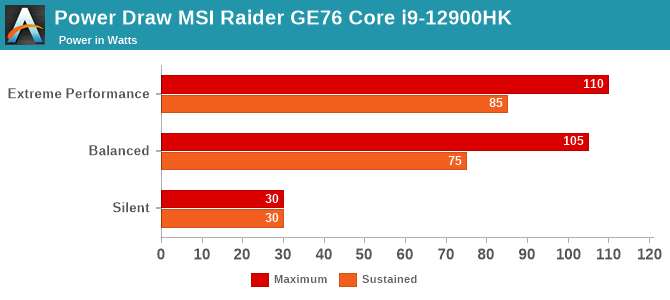
Performing a stress test on the MSI Raider GE76 proves this point very well. When the system is in its maximum performance mode, the processor initially ramps up to an almost insane 110 Watts for a brief moment, and then settles in at a still high 85 Watts for sustained operation.
In its balanced mode, the system brings PL1 down to around 75 Watts, which is still well over the 45-Watt base rating of this processor. Performance will be slightly lower, but so will the noise.
In the Silent mode, MSI drops the power level way down to just 30 Watts, so performance will be impacted significantly, although power consumption grows at a far faster rate than performance, so you don’t lose as much performance as you may think. To see just how big of a drop that is, Cinebench R20 was run in Silent Mode. The result was 3494 versus 6869 in the maximum performance mode. That is 49% less performance for 65% less power, and it is actually less power than that as well because MSI disables the PL2 completely in Silent mode, meaning the device peaks at just 30 Watts instead of 110 Watts.
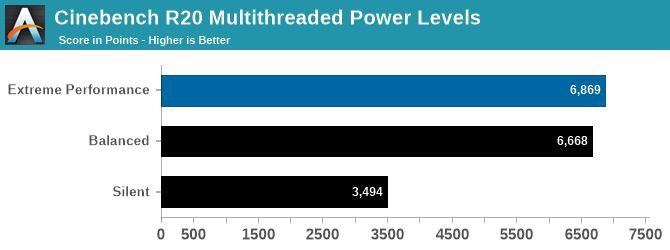
Cinebench runs pretty quickly, so even in Balanced mode the processor is still closer to PL2 than PL1 by the time the test is finished, which is why the scores are so close. On a longer benchmark the difference would be increased, but not significantly, since the sustained power level is similar between the top two modes. If you need that last few percentage points of performance, and do not mind the increased noise, it is available.
Intel and MSI are not the only two to play around with power levels. Pretty much every performance notebook will have some sort of setting to change the power levels and noise. The ASUS G513QY with the AMD Ryzen 9 5900HX has a similar system, and it also draws around 85 Watts in its maximum performance mode on a 45-Watt processor. Really, it comes down to cooling. If you have sufficient cooling, you can extract more performance. The downside is often noise, although that is also dependent on the cooling system design and the size of the notebook.
Multitasking
One of the key ideas around Alder Lake is that it offers six P-Cores and eight E-Cores. Windows 11’s thread scheduler should take advantage of the E-Cores to move intensive workloads to when that task gets moved to the background in Windows, and as such system responsiveness should be improved. Seat of the pants impressions confirm this. With a heavy load running, the system stays responsive. Apps continue to open quickly, and the in-app performance is still quite strong.
To give a more analytical look at the difference, a test was created to simulate a workload where an intensive task was shuffled to the background, and then several apps were run in the foreground and the performance measured. To achieve this, Handbrake was set to transcode a long 1080p video to 720p using the x264 software encoder. Then, that task was shuffled to the background, and both PCMark 10’s Modern Office test suite was run, as well as Cinebench R20. Performance was measured for PCMark 10, Cinebench, and Handbrake to get a feel for how the system was handling the intense load.
This test was then replicated on the ASUS G513QY with AMD’s Ryzen 5900HX and Radeon RX 6800M, as well as a MSI system with the Intel Core i9-11980HK and RTX 3060. The absolute results are not the main concern, but rather the percentage changes from running the tests individually. PCMark 10, as an example, leverages the CPU, GPU, memory, and storage, so it is a good example of a real-world test, but the GPU performance is significantly different on these three systems. Ideally, we would be able to keep all the components the same except the CPU, but we must work with what is available, unlike with desktops. That is why Cinebench was also tested, since it is purely a CPU test and does not leverage the other subsystems like memory or storage.

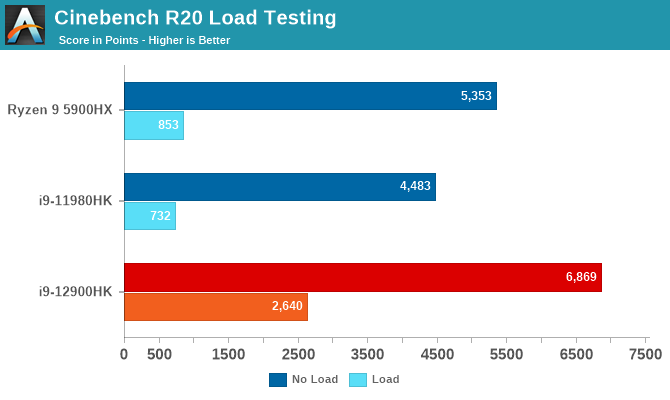
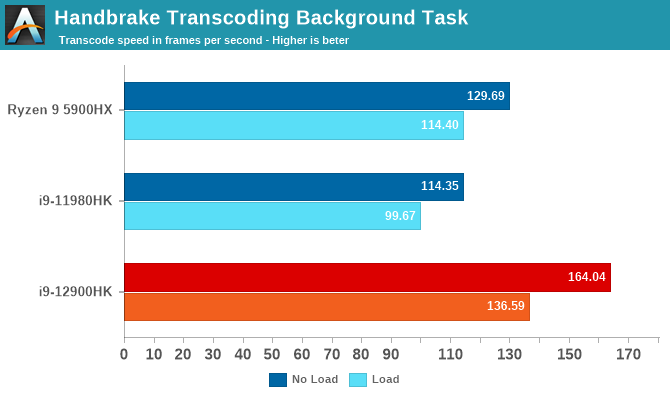
The results are very interesting and prove that Intel’s new Thread Director, coupled with Windows 11, makes a big difference in terms of usability. On PCMark 10, all the systems dropped in performance the smallest percentage, as this test is not just about the CPU, but the Alder Lake Core i9-12900HK dropped the least, with an overall result that was 82.6% of the original unloaded result. The Tiger Lake system was only able to achieve 61.9% of its original result, while the AMD system fared better at 75%.

Cinebench though was a different story, with both the Ryzen 9 5900HX and the Tiger Lake i9-11980HK only able to achieve about 16% of their original result, whereas the new Alder Lake system was still able to net 38.4% of its original score while the system was using every single core to transcode a video.
With Handbrake running in the background, all the systems were slower to transcode, but both the AMD 5900HX and Intel i9-11980HK, thanks to not being able to de-prioritize the background task, finished the transcode with a frames per second average of about 88% of the unloaded transcode would have achieved. The new Alder Lake system could only average 83% of its original frames per second, because that task was deprioritized by Thread Director to free up additional resources for the foreground jobs. That made a sizable difference on the net for all the jobs, especially Cinebench.
The new Thread Director and hybrid design is a big win for usability. No longer does an active task feel like it bogs down the system, leaving the user with an unresponsive computer to deal with. Even with the CPU running at 100% load, active tasks feel quick and net performance is very impressive. Although the Alder Lake system did give up the most performance on the background task, it was only an additional 4% over the Tiger Lake system, while at the same time achieving a much higher result on the foreground task. On Cinebench, the Alder Lake system scored 3.6 times higher than the Tiger Lake platform, while still achieving a transcode that was 1.37 times faster. It is very impressive.


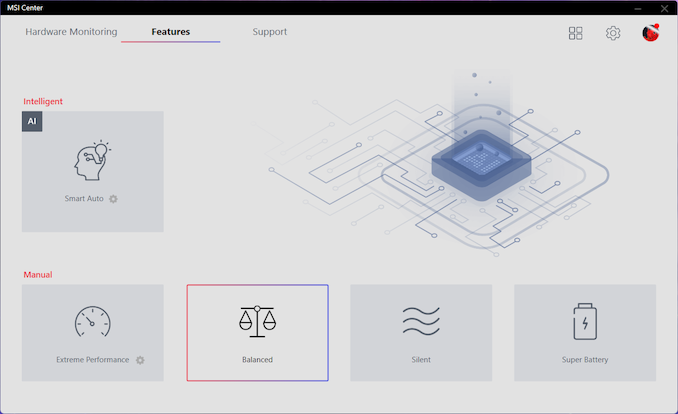








153 Comments
View All Comments
undervolted_dc - Tuesday, January 25, 2022 - link
100wh battery and 115w isn't a bit high ? is all that needed to win in benchmarks ?shabby - Tuesday, January 25, 2022 - link
Seems like it, except they always lose in the battery life benchmarknico_mach - Tuesday, January 25, 2022 - link
That battery life is U-G-L-Y for sure.mothringer - Tuesday, January 25, 2022 - link
It's a DTR, that's actually pretty good by DTR standards. Almost double what mine gets.tipoo - Tuesday, January 25, 2022 - link
In what world is a 5900 + 6800 also not a desktop replacement?temps - Tuesday, January 25, 2022 - link
the one where its performance is too poor for it to actually be used as a desktop replacementBillBear - Tuesday, January 25, 2022 - link
Except for the part where performance on this craters the second you unplug this from the wall?lilo777 - Tuesday, January 25, 2022 - link
Why would you unplug a desktop from the wall?melgross - Wednesday, January 26, 2022 - link
Because it’s not actually a desktop. It’s not that useful away from the socket though, which is a problem. But that’s been a problem for all Windows machines, no matter which CPU is inside. Performance drops to unusable levels for many software packages.TheinsanegamerN - Friday, January 28, 2022 - link
What a surprise, melgross doesnt understand how DTRs work.